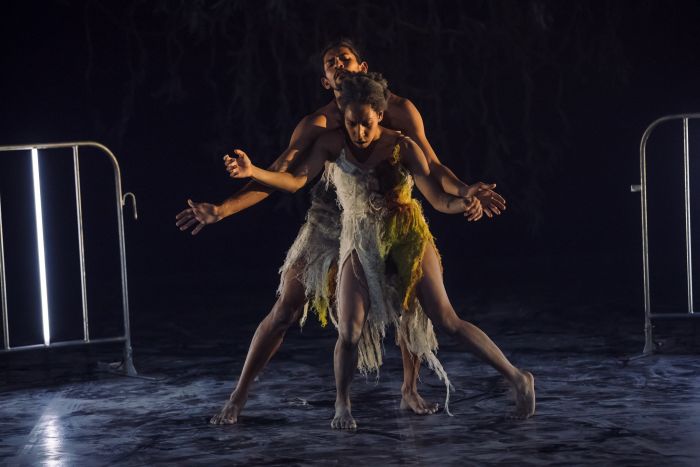“Ngathu” is the first choreographed work by Djakapurra Munyarrun, an esteemed Yolngu songman, foundation member of, and cultural consultant, teacher, and yidaki player, for Bangarra. The work draws its inspiration from the cycad (ngathu) nut, an important food source, following a traditional pattern of journeying, harvesting and preparation. There is some urgency to the task as the nut’s fruiting season is short and it must be gathered before the onset of the wet season, signalled by the call of the white cockatoo.
While of striking simplicity, “Ngathu” is profoundly moving.
The two sisters, whose loving and responsible immersion in their task of not only gathering but also carrying the vital knowledge of continued communal sustenance into the future, is memorably conveyed by Deborah Brown and Yolanda Lowatta. A binding sense of both community and cycle is carried by the circular motion of the full ensemble and graceful and frequent separations into smaller constantly moving groups. Authoritatively, the power of traditional ways to enliven the present is evoked through the juxtaposition of mesmerising traditional movement with contemporary variations. As the final two dancers depart, it is as if we have experienced a vision rather than watched a performance.
In “Place”, dancer and first-time choreographer Kaine Sultan-Babij has created a contemporary work from his struggle to discover his place in contemporary urban Australia as a gay man and a person of Croatian and Arrernte-Gurindji heritage. The first section evokes the difficulties of not fitting anywhere, the dancers struggling to insert their contorted limbs and bodies through the metal of a forbidding fence.
The second section is a complete contrast, as in lovely undulating movements, an ensemble of dancers evokes the totem of the caterpillar, an intercession which brings a sense of comfort. The edgy restraint of a beautifully choreographed duet performed by Yolanda Lowatta and Tyrel Dulvarie, suggests a further discovery. A triumphant but agonised solo is performed by an impressive Leonard Mickelo, who, astride the fence, finally proclaims himself free to be who he is.
The third offering, “Whistler”, is the first choreographed work of Nicola Sabatini and the third creation of the remarkable Elmer Kris. Both Torres Strait Islander women were inspired by the call of the dugong, sacred to their people, and the flowing and ebbing movement of the whole expresses the deep connection between the sea and the Islanders. A highlight was the rolling, roiling moving of the sea grasses capturing constant and erratic movement of this most productive of ecosystems. A fitting finale to this gentle rhythmic tribute to the life cycle of the dugong was the joyous singing of the full ensemble. It seemed almost an invitation to join our own voices with the dancers in celebration of their island culture.
Once again, the music of Steve Francis, Jacob Nash’s all-purpose and wonderful waterfall of leaves, the atmospheric lighting of Matt Cox and Jennifer Irwin’s interestingly textured costumes give the fullest support to the work of the three debut choreographers. Last, as always, thanks must go Bangarra’s Artistic Director, Stephen Page, for his nurturing of emerging voices.





